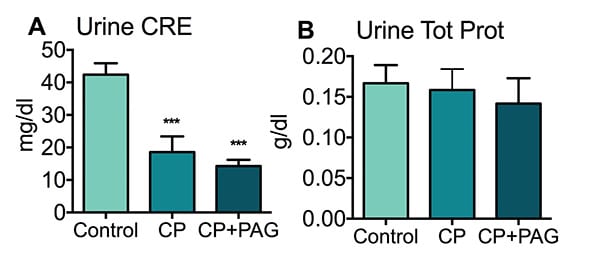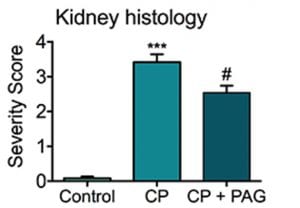Acute Nephritis Model
Discover how Melior’s unique phenotypic screening platforms can uncover the untapped value of your candidate therapeutic
Nephritis can be modeled in rats with an intraperitoneal injection of the chemotherapeutic agent CSPLTN.
Acute nephritis is characterized by altered blood and urine chemistries, as well as histological evidence of kidney tubule damage and inflammatory cell infiltration. Pre-treatment with DL-propargylclycine (PAG) has been suggested to reduce these markers of injury.
In this study, PAG was tested for effects on CSPLTN-induced changes in blood and urine chemistries, along with histological examination of kidney tissue after treatment.
Blood chemistry. Blood chemistry levels in plasma samples from CSPLTN (CP) challenged rats. On day five of the study, blood plasma samples were collected and analyzed for various markers of kidney function. Blood nitrogen urea (BUN), Creatine (CRE) and Sodium (Na) were significantly increased after CSPLTN challenged compared to untreated controls. PAG attenuated the increase in these kidney markers. Data are mean ± SEM; ***p<0.001 compared to untreated control, #p<0.05 compared to CSPLTN (N=12).
Urine chemistry. Urine chemistry levels in plasma samples from CSPLTN (CP) challenged rats. On day five of the study, twenty-four hour urine samples were collected and analyzed for various markers of kidney function. Creatine (CRE) was significantly decreased after CSPLTN challenge compared to untreated controls (A). PAG treatment did not significantly alter levels of these markers compared to CP-only treated animals. There were no significant changes in total urine protein (B). Data are mean ± SEM; ***p<0.001 compared to untreated control (N=12).
Kidney histology. Morphological assessment of kidney tissue from CSPLTN challenged rats. On day five of the study, kidney samples were collected, fixed and analyzed histologically with H&E staining. CSPLTN caused a marked pathological response including extensive cell injury in the cortex and outer medulla (B) compared to non-treated controls (A). Rats treated with PAG (C) displayed significantly less severe pathology compared to CSPLTN (CP) alone. Data are mean ± SEM; ***p<0.001 compared to untreated control, #p<0.05 compared to CSPLTN (N=12).







 Interested in running an Acute Nephritis study?
Interested in running an Acute Nephritis study?